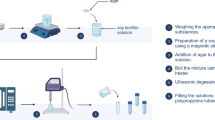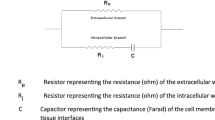Abstract
Radiofrequency coils are used as sensors in various applications such as nuclear magnetic resonance (NMR) imaging and displacement cardiograms (DCGs). In most cases the impedance and the resonant frequency of the coil are monitored to provide the required information. The paper describes the changes in reflected impedance and in resonant frequency of a coil when it is placed near a medium with properties ranging from a lossy dielectric to a pure conductor. The theory of interaction between the coil and the medium is investigated and a model based on the use of vector potentials is developed. One prediction of the theory is that placing the coil over body equivalent saline (lossy dielectric) at 15 MHz results in an increase in the inductance of the coil and a resultant decrease in resonant frequency. This prediction was supported experimentally.
Similar content being viewed by others
References
Benidi, L. (1980) Analysis of the electromagnetic interaction between a resonator and a lossy dielectric body as a first approach to non-invasive heart movement detection.IEEE Trans.,BME-27, 623–630.
Cheng, D. (1964) The reflected impedance of a circular coil in the proximity of a semi-infinite medium. Ph.D Dissertation, University of Missouri, Columbia, Jan. 1964.
Cheng, D. (1965) The reflected impedance of a circular coil in the proximity of a semi-infinite medium.IEEE Trans.,IM-14, 107–116.
Fenton, T. R. andVas, R. (1973) Measuring characteristics of the displacement cardiograph.Med. & Biol. Eng.,11, 552–559.
Gay, T. C., Vas, R., Pittman, D. E., Joyner, C. R. andMontello, N. J. (1976) The displacement cardiograph: a noninvasive technique for recording myocardial wall motion.Circ.,53, 139–143.
Harpen, M. D. (1988) Influence of skin depth on NMR coil impedance.Phys. in Med. & Biol.,33, 329–337.
Kwok, M. C. (1988) Detection of cardiac motion via electromagnetic coupling. Ph.D Thesis, University of Kent, Canterbury, UK, May 1988.
Langmuir, R. V. (1961)Electromagnetic fields and waves. McGraw-Hill Book Co. Inc.
McGonnagle, W. J. (1961)Non-destructive testing. McGraw-Hill, New York.
Schuder, J. C. (1976) Incremental impedance of circular coil moved from free space to surface of semi-infinite conductive region.Dig. 11th Int. Conf. Med. & Biol. Eng., Ottawa, Ontario, Canada, 269–297.
Silverberg, R. A., Diamond, G. A., Vas, R., Tzivoni, D., Swan, H. J. C. andForrester, J. S. (1980) Non-invasive diagnosis of coronary artery disease: the cardiokymographic stress test.Circ.,61, 579–589.
Tarjan, P. P. andMcFee, R. (1968) Electrodeless measurements of the effective resistivity of the human torso and head by magnetic induction.IEEE Trans.,BME-15, 266–278.
Vas, R. (1967) Electronic device for physiological kinetic measurement and detection of extraneous bodies. ——Ibid. -14, 2–6.
Vas, R. (1976) The displacement cardiograph. ——Ibid. -23, 49–54.
Wilson, D. L. (1981) Physical principle of the displacement cardiograph including a new device sensitive to variation in torso resistivity. ——Ibid. -28, 702–710.
Author information
Authors and Affiliations
Rights and permissions
About this article
Cite this article
Kwok, M.C., Pepper, M.G. Noninvasive detection of ventricular wall motion by electromagnetic coupling. Med. Biol. Eng. Comput. 29, 136–140 (1991). https://doi.org/10.1007/BF02447098
Received:
Accepted:
Issue Date:
DOI: https://doi.org/10.1007/BF02447098




